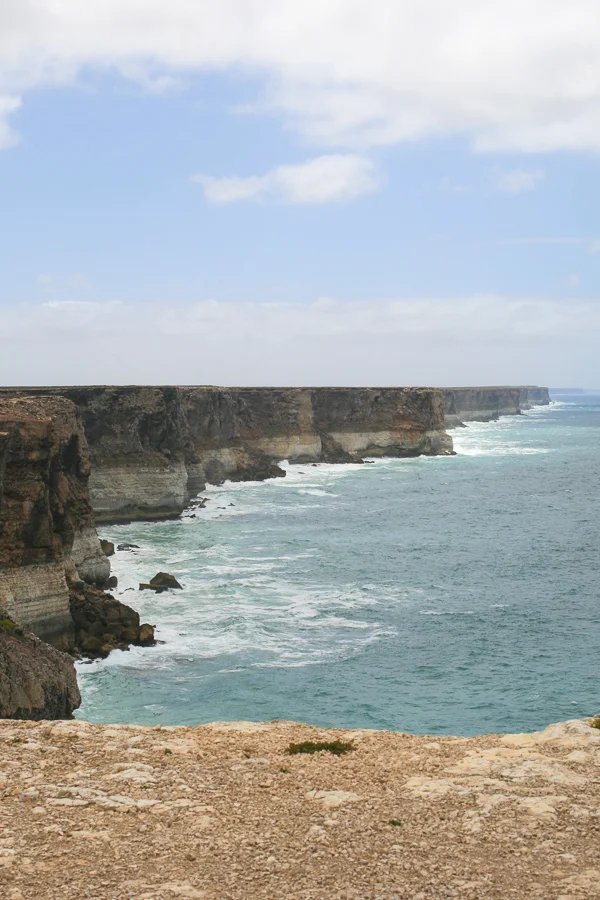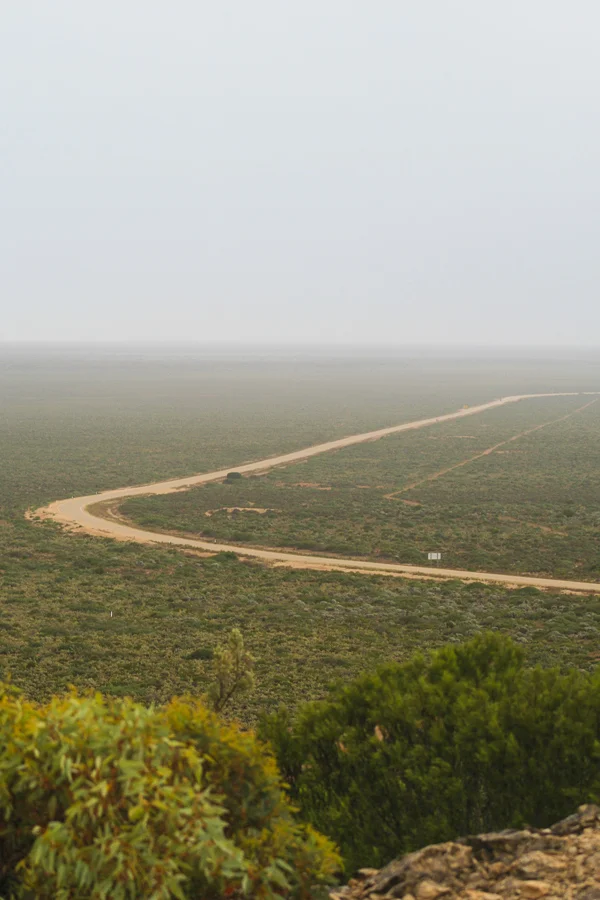Our Delicious Adventure - The Nullarbor Crossing - South Australia to Western Australia
/We had planned to leave Streaky Bay in the cool of the afternoon and drive for four to five hours before setting up camp at the Nullarbor Roadhouse early in the evening. However, the cool of the afternoon never arrived that day which put us a little behind schedule packing up, and when we departed it was still 38°C at five o’clock in the afternoon! We had heard much about ‘crossing the Nullarbor’, it had been described as a relatively easy but very long drive, so we had a combination of excitement and some trepidation about what lay ahead. We had been warned and so were prepared with plenty of fuel with a spare tank stored in our boat, plenty of drinking water and food snacks, spare tyres for the car and boat trailer, a toolbox, car jack, bottle jack, jumper leads, battery charger, even extra wheel bearings for the boat trailer. We had sun hats, sun cream, fly swatters and a first aid kit, all on board just in case of emergency on a remote section of the highway.
Sixty five kilometres along we reached the town of Ceduna, the major commercial centre of the far west of the Eyre Peninsula. Ceduna was the last big town we would see before reaching the other side of this legendary crossing, some 1,500km away in Norseman, Western Australia. Along the way there would be a scattering of smaller townships, and then fuel stops and roadhouses about every 200km for the majority of the crossing. We passed by Penong and as the light began to fade and the temperature soared to 42°C we were treated to an incredible sunset on the distant horizon. Such colours in the sky as you wouldn’t believe were possible, changing every few minutes and getting more and more spectacular. As we enjoyed the display we were also aware that as the beautiful sunset faded only precious minutes of daylight remained, and we were now going to be setting up camp in the dark.
We arrived in the small township of Nundroo which offered motel accommodation, a roadhouse for fuel, basic supplies and hot food, plus a caravan park. We were blissfully unaware as we arrived in town that on these isolated stretches of road these little places don’t stay open all night like a city hotel. As we rolled into Nundroo we watched in dismay as the young guy inside the roadhouse turned the sign on the door from open to closed. I ran over to the door and tapped on the glass pane and he kindly stopped and turned around to unlock the door asking us ‘did we want fuel?’ Without hesitation I replied, ‘No, we are after a powered campsite for the night?’ with a pleading tone in my voice. He let us in and we secured a site for our tent. He mentioned to us that the ground was a little hard for pegging, which later proved to be quite the understatement. Following his instructions, we gingerly made our way in the darkness to the camping area. It was our first time setting up in the dark, and it turns out doing so was rather an unwise thing to do in such an inhospitable place.
There was a scattering of caravans already in position, and most occupants were seated outside under the starlit sky desperate for relief from the relentless heat. A short, elderly man wearing an old white singlet (which did its best to cover his pot belly) stared with surprise and then smiled at us as we drove in so late in the evening with our boat in tow. He was accommodated in the smallest old caravan on the site next to ours, and he and his little wife of many years warmly greeted us. It was clear that we were going to be the evening’s entertainment for the surrounding travellers as we proceeded to park, unload, grope in the darkness for our power supply and pitch our tent with the assistance of torchlight. As we continued to vigorously hammer our tent pegs into what seemed like rock, our new neighbor and friend proceeded to tell Mr G of his own hardships of the day suffering not one but two flat tyres in his travels. It should be noted that it was now ten o’clock at night, still very hot and with not a breath of wind in sight. We decided to only erect the shell of the tent and not bother with the fly (The fly works as a bit of a security blanket over a tent for those non campers reading, it covers your tent to protect from rain, wind and bird droppings, keeping things firm and snug). However, as we were only erecting the tent for a short overnight stay, and since there was no sign of wind or rain and the birds had gone to bed, we decided to skip the fly making for a quicker pack up the next morning.
Once settled, it was unbearably hot in the tent regardless of the fact we had all the windows and door flaps open, but this was all we could do and we did our best to get some rest. Sometime in the next hour an unexpected wind began to blow bringing some welcome relief to the heat. However, with it came large amounts of fine red dust in our tent windows, so Mr G ventured out to close all the openings to prevent a total dust bath and we continued to doze. The wind seemed to be gaining momentum: loud flapping noises and shaking of the tent frame began, as the adventurer slept soundly beside us. Mr G and I were now wide awake wondering whether the tent would survive such force or whether we would be literally blown away, we both knew if the wind did not relent soon our tent was going to fail us. Within the next few minutes, the wind had gained such force that we could hear corrugated iron roofing coming loose, loud banging and crashing sounds were going on outside around us. By now we were quite concerned, and panic soon followed when our tent gave up the fight and the frame snapped, one of the frame support poles had popped from its socket and the whole thing collapsed on top of us. As the adventurer still continued to sleep while turmoil surrounded him, Mr G swiftly exited the tent to investigate the possibility of repairs, whilst I remained inside holding up the tent in the middle. Our kindly neighbour came out of his van to see if he could help, offering us extra rope to tie things down, however his van door nearly flew off it’s hinges and his wife beckoned him back inside to safety. Mr G struggled to fight the wind, attempting to reinsert the pole back into the socket as the fine red dust took up residence in his eyes, ears, nose, throat and any other available crevice. After a few minutes of consistent effort we realised it was a fruitless exercise to make repairs in such impossible conditions, and to avoid further damage we had no other choice but to pack it up and sleep in the car.
Waking the adventurer, we instructed him for his own safety to relocate to the back seat of the car and ‘stay put’ while we sorted things out. Packing up a broken tent in gale force winds in the dark proved to be a difficult task, our nerves were frayed and our patience had worn very thin. By midnight we had managed to shove everything back into the boot of the car or under the boat cover and Mr G and I then made ourselves ‘not very comfortable’ in the two front seats of the car, thankful to be safe and out of the wind. I don’t think I have ever felt such gratitude or affection for our car as I did that night, it truly was our refuge and we sat relieved trying to rest until sunrise.
The sun rose about five thirty the next morning, the wind had relented and one by one the caravans departed to continue on their travels. Kind and sympathetic smiles greeted us as we limped out of our vehicle, bodies stiff, tired, dusty and disheveled, not quite ready to laugh about the previous night’s events but exceptionally relieved it was over. In the calm of the morning daylight Mr G was able to semi-repair the tent, good enough to use until we could pick up a needed spare part back in civilisation. After a scrappy breakfast of cereal and toast we hit the road again about seven o’clock. As we exited the camping area we noticed a sign that had also been hidden from us in the darkness the night before, it said CAUTION - NO PEGGING. All we could do was take a photo, knowing one day it would make us laugh.
Ahead of us lay the Head of the Bight and The Nullarbor Plain. The Head of the Bight is one of the most spectacular whale watching sites in the world, with a cliff top boardwalk leading to a viewing platform. Although we weren’t visiting in whale season, we still enjoyed walking the boardwalk to see the magnificent cliffs and rugged coastline. Not much further along the road we refueled the car and grabbed some lunch at the Nullarbor Roadhouse, which also offers motel accommodation and camping facilities. Next we passed the sign for the beginning of The Nullarbor Plain, known as the treeless plain (‘nullus arbor’ loosely translated means ‘no trees’). The Nullarbor Plain, at it’s widest point, stretches about 1,100km from east to west across the border region between South Australia and Western Australia. It is well worth pulling in at the sign posted lookouts along the road for more breathtaking views. Each lookout is just a few minutes detour from the main road and did bring us welcome relief to see something different than the endless sealed road and monotonous landscape we had been travelling through. It was quite surreal standing at the top of the eighty metre high Bunda Cliffs and looking back across these sheer cliffs that line the Great Australian Bight, it really was spectacular.
As you approach the South Australia/Western Australia border, there is a quarantine check point where all fruit, vegetables, nuts, seeds, cheese and honey cannot pass interstate to avoid the trafficking of pests and disease (particularly fruit fly) from state to state. The first town over the border is Eucla and we made the 4km detour out to the ruins of the original telegraph station building, which is now half buried in the surrounding coastal sand dunes. After a full day of driving we arrived at Madura Pass where we surrendered the idea of another night of camping and instead booked into a motel room for the night. Although it was a very basic room, it had a comfy bed and a very welcome hot shower for us to wash off the Nundroo dust that was still lingering from our adventure the night before.
As we drove out the next morning and further west, Madura Pass boasted spectacular views of the Roe Plains and an outlook towards the Southern Ocean from the lookout at the top of the pass. Our next day of driving was really about covering the distance as safely and speedily as we could, with stops at Cocklebiddy, Caiguna and Balladonia roadhouses for fuel and food, then finally onto Norseman marking the end of our crossing. Although we were quite wearied from the long days of driving, we had made it to Western Australia.
© Excerpt from Our Delicious Adventure - Recipes and Stories of Food and Travel by Jane Grover







